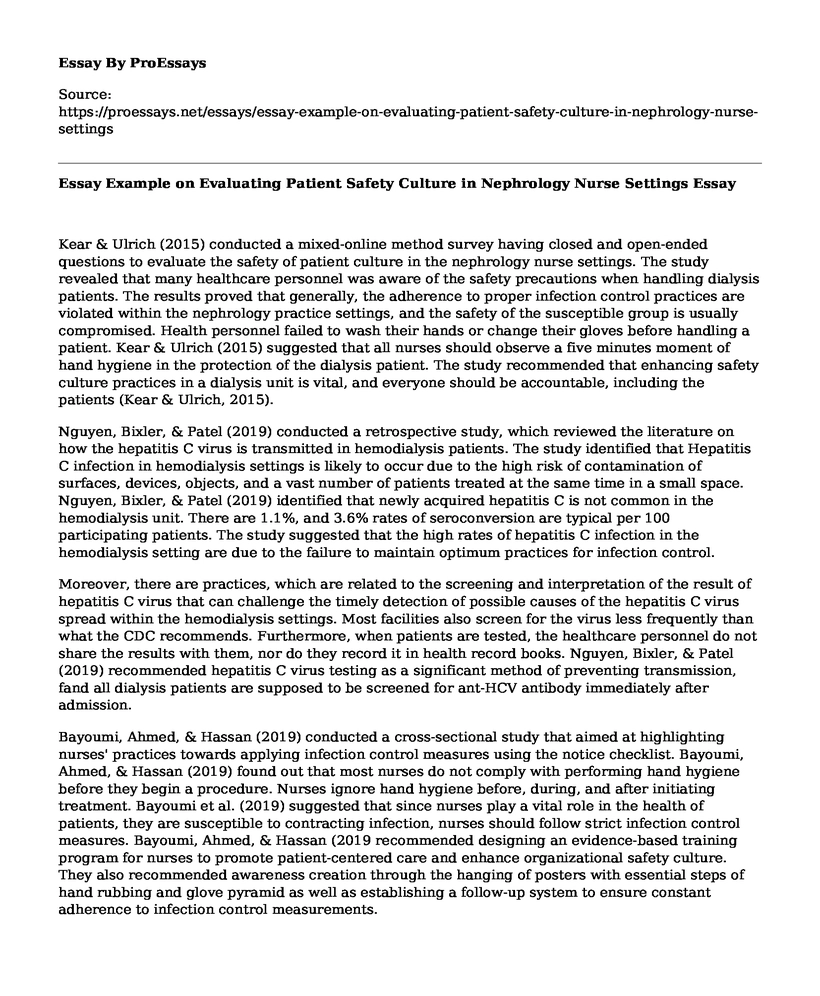Kear & Ulrich (2015) conducted a mixed-online method survey having closed and open-ended questions to evaluate the safety of patient culture in the nephrology nurse settings. The study revealed that many healthcare personnel was aware of the safety precautions when handling dialysis patients. The results proved that generally, the adherence to proper infection control practices are violated within the nephrology practice settings, and the safety of the susceptible group is usually compromised. Health personnel failed to wash their hands or change their gloves before handling a patient. Kear & Ulrich (2015) suggested that all nurses should observe a five minutes moment of hand hygiene in the protection of the dialysis patient. The study recommended that enhancing safety culture practices in a dialysis unit is vital, and everyone should be accountable, including the patients (Kear & Ulrich, 2015).
Nguyen, Bixler, & Patel (2019) conducted a retrospective study, which reviewed the literature on how the hepatitis C virus is transmitted in hemodialysis patients. The study identified that Hepatitis C infection in hemodialysis settings is likely to occur due to the high risk of contamination of surfaces, devices, objects, and a vast number of patients treated at the same time in a small space. Nguyen, Bixler, & Patel (2019) identified that newly acquired hepatitis C is not common in the hemodialysis unit. There are 1.1%, and 3.6% rates of seroconversion are typical per 100 participating patients. The study suggested that the high rates of hepatitis C infection in the hemodialysis setting are due to the failure to maintain optimum practices for infection control.
Moreover, there are practices, which are related to the screening and interpretation of the result of hepatitis C virus that can challenge the timely detection of possible causes of the hepatitis C virus spread within the hemodialysis settings. Most facilities also screen for the virus less frequently than what the CDC recommends. Furthermore, when patients are tested, the healthcare personnel do not share the results with them, nor do they record it in health record books. Nguyen, Bixler, & Patel (2019) recommended hepatitis C virus testing as a significant method of preventing transmission, fand all dialysis patients are supposed to be screened for ant-HCV antibody immediately after admission.
Bayoumi, Ahmed, & Hassan (2019) conducted a cross-sectional study that aimed at highlighting nurses' practices towards applying infection control measures using the notice checklist. Bayoumi, Ahmed, & Hassan (2019) found out that most nurses do not comply with performing hand hygiene before they begin a procedure. Nurses ignore hand hygiene before, during, and after initiating treatment. Bayoumi et al. (2019) suggested that since nurses play a vital role in the health of patients, they are susceptible to contracting infection, nurses should follow strict infection control measures. Bayoumi, Ahmed, & Hassan (2019 recommended designing an evidence-based training program for nurses to promote patient-centered care and enhance organizational safety culture. They also recommended awareness creation through the hanging of posters with essential steps of hand rubbing and glove pyramid as well as establishing a follow-up system to ensure constant adherence to infection control measurements.
Lewis, Clark, Benda, & Hardwick (2014) conducted a macro ergonomic analysis design study to evaluate the reason for the increased rate of re-hospitalization of hemodialysis patients. (Lewis et al., 2014) discovered that the rates of re-hospitalization of hemodialysis patients are due to multiple external factors such as healthcare workers not adhering to infection control measures. The study suggested that inconsistent adherence to infection control measures is a result of organizational and external environmental factors such as service area demographics, suppliers of equipment and machines, and policies of the hospital (Lewis et al., 2014). (Lewis et al., 2014) recommended that understanding of the misalignments is the initial step, and addressing of such misalignments by developing interventions for the reduction of Healthcare-Associated Infections or even addressing any other safety challenges patients face is significant.
References
Lewis, V. R., Clark, L., Benda, N., & Hardwick, M. J. (2014). Reducing healthcare-associated infections in an ambulatory dialysis unit: Identification and alignment of work system factors. American Journal of Infection Control, 42(10), 284-290.
Kear, T., & Ulrich, B. (2015). Decreasing infections in nephrology patient populations: back to basics. Nephrology Nursing Journal, 42(5), 431-444.
Nguyen, D. B., Bixler, D., & Patel, P. R. (2019). Transmission of hepatitis C virus in the dialysis setting and strategies for its prevention. Seminars in Dialysis, 32(2), 127-134.
Bayoumi, M., Ahmed, A., & Hassan, H. (2019). Nurses' practices toward applying infection control measures using NOTICE checklists at a dialysis unit. Connect: The world of Critical Care Nursing, 13(2), 90-101.
Cite this page
Essay Example on Evaluating Patient Safety Culture in Nephrology Nurse Settings. (2023, Apr 18). Retrieved from https://proessays.net/essays/essay-example-on-evaluating-patient-safety-culture-in-nephrology-nurse-settings
If you are the original author of this essay and no longer wish to have it published on the ProEssays website, please click below to request its removal:
- Wrong-Site Surgery Event
- An Awkward Conversation About HPV That Can Save You From Cancer
- Change in Nursing: Lewin's Change Theory Essay
- Effective and Practical Methods of Providing Antimicrobial Therapy Article Review Paper Example
- Essay Example on Italian Traditional Health Beliefs
- Technology Trends in Nursing and Healthcare Essay
- Paper Example on Fall Prevention in Older Adults: Assessing the Economic Burden







